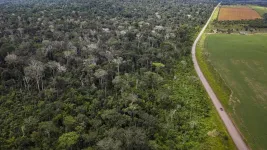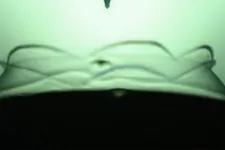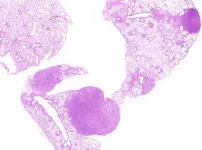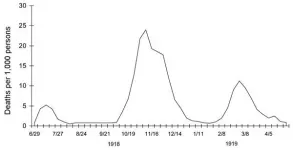(Press-News.org) Throughout history, people of different cultures and stages of evolution have found ways to adapt, with varying success, to the gradual warming of the environment they live in. But can the past inform the future, now that climate change is happening faster than ever before?
Yes, say an international team of anthropologists, geographers and earth scientists in Canada, the U.S. and France led by Université de Montréal anthropologist Ariane Burke.
In a paper published today in the Proceedings of the National Academy of Sciences, Professor Burke and her colleagues make a case for a new and evolving discipline called "the archeology of climate change."
It's an interdisciplinary science that uses data from archeological digs and the palaeoclimate record to study how humans interacted with their environment during past climate-change events such as the warming that followed the last ice age, more than 10,000 years ago.
What the scientists hope to identify are the tipping points in climate history that prompted people to reorganize their societies to survive, showing how cultural diversity, a source of human resilience in the past, is just as important today as a bulwark against global warming.
"The archaeology of climate change combines the study of environmental conditions and archaeological information," said Burke, who runs the Hominin Dispersals Research Group and the Ecomorphology and Paleoanthropology Laboratory.
"What this approach allows us to do identify the range of challenges faced by people in the past, the different strategies they used to face these challenges and ultimately, whether they succeeded or not."
For instance, studying the rapid warming that occurred between 14,700 and 12,700 years ago, and how humans coped with it as evidenced in the archeological record, can help climate specialists model possible outcomes of climate change in the future, Burke said.
Her paper is co-authored with UdeM anthropologist Julien Riel-Salvatore and colleagues from Bishop's University, Université du Québec à Montréal, the University of Colorado and the CNRS, in France.
Historically, people from different walks of life have found a variety of ways to adapt to the warming of their climate, and these can inform the present and help prepare for the future, the researchers say.
For example, traditional farming practices - many of which are still practiced today - are valid alternatives that can be used to redesign industrial farming, making it more sustainable in the future, they say.
Indigenous cultures have a major role to play in teaching us how to respond to climate change -in the Canadian Arctic, for instance, Indigenous people have a detailed knowledge of the environment that's key to be essential to planning a sustainable response, said Burke.
"Similarly, indigenous farmers all over the world cultivate a wide variety of crop types that won't all respond to changing climate conditions in the same way," she said. "They are preserving crop diversity in the global food chain and if and when the main crop types we currently rely on fail, this diversity could well prove to be a lifeline.
Another example is the readoption in northeastern North America of multi-cropping agriculture based on the "three sisters": corn, squash and beans. "There are archeological models for that," said Burke, "and the point is to use them to come up with more sustainable, locally scaled ways of farming that will ensure food security in the years to come.
INFORMATION:
About this study
"The archeology of climate change: the case for cultural diversity," by Ariane Burke et al, was published July 19 in the Proceedings of the National Academy of Sciences. Funding was provided by the Fonds de recherche du Québec - Société et culture.
A major drought and forest fires in the Amazon rainforest killed billions of trees and plants and turned one of the world's largest carbon sinks into one of its biggest polluters.
Triggered by the 2015-16 El Niño, extreme drought and associated mega-wildfires caused the death of around 2.5 billion trees and plants and emitted 495 million tonnes of CO2 from an area that makes up just 1.2 per cent of the entire Brazilian Amazon rainforest, and 1 per cent of the whole biome.
The stark findings, discovered by an international team of scientists working for more than eight years on a long-term study in the Amazon before, during and after the El Niño, have significant implications for global efforts to control the atmospheric ...
The oil industry, pharmaceutical companies and bioreactor manufacturers all face one common enemy: bubbles. Bubbles can form during the manufacturing or transport of various liquids, and their formation and rupture can cause significant issues in product quality.
Inspired by these issues and the puzzling physics behind bubbles, an international scientific collaboration was born. Stanford University chemical engineer Gerald Fuller along with his PhD students Aadithya Kannan and Vinny Chandran Suja, as well as visiting PhD student Daniele Tammaro from the University of Naples, teamed up to study how different kinds of bubbles pop.
The researchers were particularly interested in bubbles with proteins embedded on their surfaces, which is a common occurrence in the pharmaceutical industry ...
New research has found marine seismic surveys used in oil and gas exploration are not impacting the abundance or behaviour of commercially valuable fishes in the tropical shelf environment in north-western Australia.
The research is the first of its kind to use dedicated seismic vessels to measure the impacts of the survey's noise in an ocean environment, with the eight-month experiment conducted within a 2500 square kilometre fishery management zone near the Pilbara coast.
It involved using multiple acoustic sensors, tagging 387 red emperor fish and deploying more than ...
KRAS was one of the first oncogenes to be identified, a few decades ago. It is among the most common drivers of cancer and its mutations can be detected in around 25 per cent of human tumours. The development of KRAS inhibitors is, thus, an extremely active line of research. Effective results have been elusive so far, though - no KRAS inhibitor had been available until a month ago, when the FDA granted approval to Sotorasib.
KRAS encodes two gene products, KRAS4A and KRAS4B, whose levels can vary across organs and embryonic stages. When KRAS mutates, both variants, or isoforms, are activated. Though, some studies have focussed on approaches to target only KRAS4B, since it usually found to be expressed at ...
Evidence shows that early detection and treatment of cancer can significantly improve health outcomes, however women in Mississippi, particularly in underserved populations, experience the worst health outcomes for cervical, breast, and oropharyngeal cancer. ...
From the onset of the COVID-19 pandemic there have been countless comparisons to the 1918 influenza pandemic in terms of overall medical impact. Many of the comparisons addressed overall cases which, given the lack of a confirmatory lab test in 1918 and no meaningful case definitions for both pandemics, make such comparisons patently invalid. Overall mortality comparisons, although methodologically flawed as well, do offer a reasonably comparative outcome measure and offers a greater degree of validity. This measure is further enhanced when adjusted for population and average life years lost (see accompanying table for mortality comparisons ...
Researchers at Michigan Medicine have discovered yet another functional autoantibody in COVID-19 patients that contributes to the disease's development and the "firestorm" of blood clots and inflammation it induces.
A growing body of studies suggests COVID-19 emulates many aspects of systemic autoimmune disorders, including the release of a flurry of overactive immune cells that produce toxic webs of proteins and DNA called neutrophil extracellular traps, or NETs.
For this study, the team analyzed serum from over 300 hospitalized COVID patients, searching for a novel autoantibody that shields the toxic NETs from being destroyed and produces a lasting ...
The link between on-road traffic and air pollution is well-known, as are the negative health impacts of pollution exposure. However, the many factors that may influence commuters' exposure to pollutants - such as frequency, time, and duration of commute - and the overall impact of commuting remains a matter of on-going scientific discovery.
Dr. Jenna Krall, assistant professor at the George Mason University College of Health and Human Services, is using statistical methods to better understand exposure to air pollution. Krall studies how commuting patterns impact exposure to fine particulate matter ...
EAST LANSING, Mich. - Tens of millions of patients around the world suffer from persistent and potentially life-threatening wounds. These chronic wounds, which are also a leading cause of amputation, have treatments, but the cost of existing wound dressings can prevent them from reaching people in need.
Now, a Michigan State University researcher is leading an international team of scientists to develop a low-cost, practical biopolymer dressing that helps heal these wounds.
"The existing efficient technologies are far too expensive for most health care systems, ...
Researchers at the University of Maryland School of Medicine (UMSOM) launched a new online tool that could more quickly advance medical discoveries to reverse progressive hearing loss. The tool enables easy access to genetic and other molecular data from hundreds of technical research studies involving hearing function and the ear. The research portal called gene Expression Analysis Resource (gEAR) was unveiled in a study last month in Nature Methods. It is operated by a group of physician-scientists at the UMSOM Institute for Genome Sciences (IGS) in collaboration with their colleagues at other institutions.
The portal allows researchers to rapidly access data and provides easily interpreted visualizations of datasets. Scientists can also input ...




